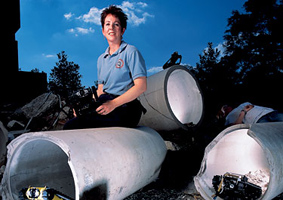Robin Murphy - Search and Rescue Robots
 In this podcast we interview Robin Murphy who is a founder and international leader in both rescue robotics and human-robot interaction, and was recognized by TIME Magazine in 2004 as an innovator in artificial intelligence. Her work in rescue robotics began in 1995, investigating artificially intelligent robots and new concepts of cooperative teams such as marsupial and heterogeneous teams, while also working directly with responders to establish the domain theory. As the Director of the Center for Robot-Assisted Search and Rescue (CRASAR) at the University of South Florida she was the first to introduce ground, air, and sea robots to disaster response, participating in the World Trade Center disaster (2001), La Conchita, CA, mudslides (2005), Hurricanes Charley (2004), Dennis (2005), Katrina (2005), and Wilma (2005), and the Newmont Midas (2007) and Crandall Canyon (2007) mine disasters.
In this podcast we interview Robin Murphy who is a founder and international leader in both rescue robotics and human-robot interaction, and was recognized by TIME Magazine in 2004 as an innovator in artificial intelligence. Her work in rescue robotics began in 1995, investigating artificially intelligent robots and new concepts of cooperative teams such as marsupial and heterogeneous teams, while also working directly with responders to establish the domain theory. As the Director of the Center for Robot-Assisted Search and Rescue (CRASAR) at the University of South Florida she was the first to introduce ground, air, and sea robots to disaster response, participating in the World Trade Center disaster (2001), La Conchita, CA, mudslides (2005), Hurricanes Charley (2004), Dennis (2005), Katrina (2005), and Wilma (2005), and the Newmont Midas (2007) and Crandall Canyon (2007) mine disasters.
In order to facilitate the transfer of research to industry and the emergency response community, in 2003 she established in partnership with the University of Minnesota the NSF Industry/University Cooperative Research Center on Safety, Security, and Rescue Technology, which she directed from 2003 to 2006.

From the RobocupRescue Competition to an actual disaster site the step is immense and the path is scattered with unthought-of challenges. Unless your robot robustly fits the terrain or is one-size fits all (i.e. it can fly, slither, jump, and swim) and you've done the training (Murphy is technical search specialist, Florida Task Force 3 regional urban search and rescue team), it might not make the cut. Further challenges are rescuer-robot interactions, victim-robot interactions and the logistics involved in moving quickly to the disaster area. In the end, search and rescue robots need to become a priority on the shopping-list of disaster relief agencies to be efficient. The market, however, is not quite ready.
Links:


0 Comments:
Post a Comment
<< Home